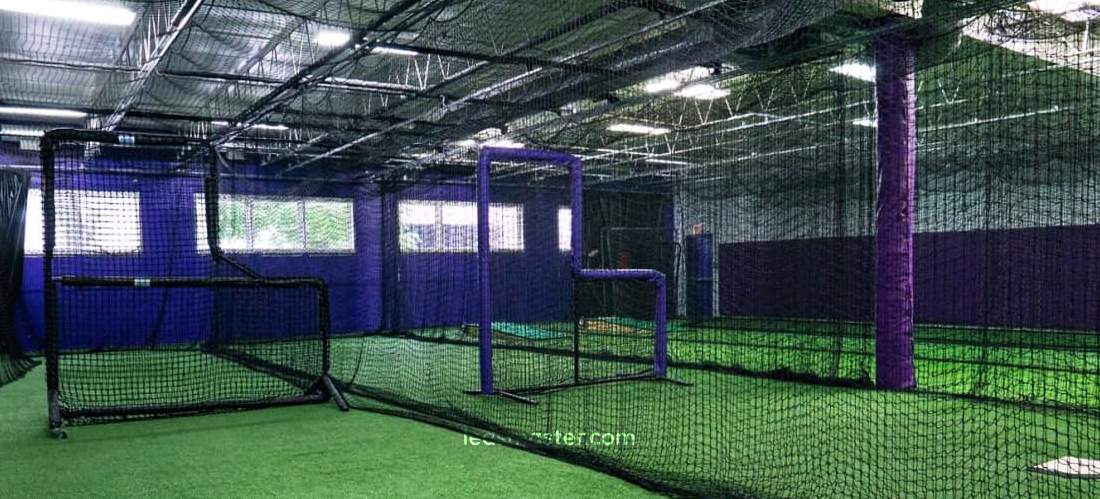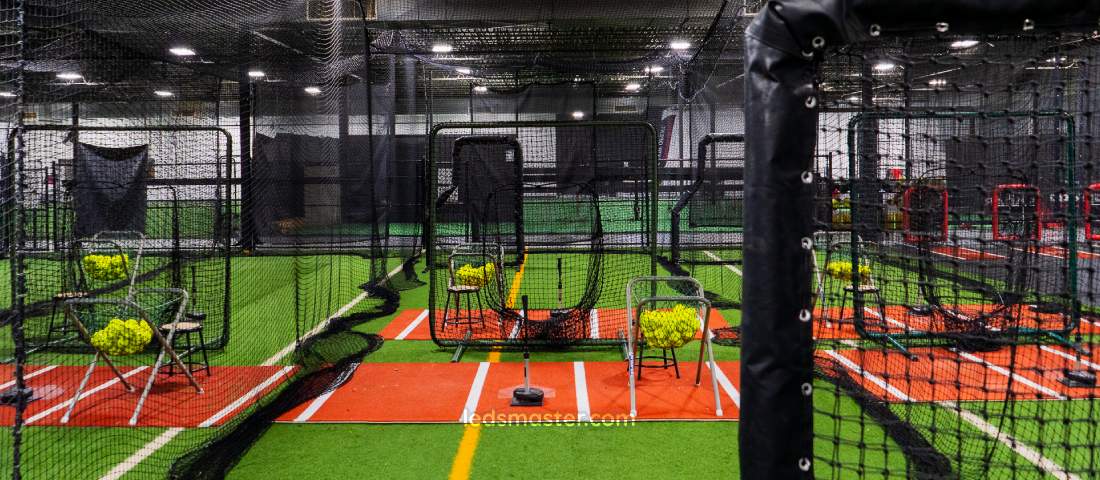Whether you’re outfitting an indoor training facility or enhancing an outdoor practice area, our cutting-edge LED fixtures offer unmatched energy efficiency and superior performance.Elevate your batting experience with lighting that sets the standard for clarity, reliability, and sustainability.
Batting cages are indispensable facilities for baseball and softball training, providing controlled environments for players to practice their skills. Adequate lighting plays a crucial role in ensuring optimal visibility, safety, and performance. This article explores essential considerations and best practices in lighting for both indoor and outdoor batting cages, addressing various technical specifications, standards, and practical implementation.
Get your complimentary lighting design today
Table of Contents
ToggleThe illuminance requirements for indoor and outdoor batting cages are tailored to their specific environmental conditions and usage scenarios, influencing how lighting is designed and implemented in each setting.
Indoor batting cages operate in controlled environments where natural daylight is minimal or absent, necessitating higher lux levels to ensure optimal visibility for players. Lux, a measure of illuminance, directly impacts how well players can see the ball, judge its trajectory, and react accordingly during practice or training sessions. To meet standard playing conditions, indoor batting cages typically require a minimum of 300 lux evenly distributed across the cage area.
This higher lux requirement in indoor settings compensates for the lack of natural light and ambient illumination, ensuring that players can track the ball effectively against the backdrop of uniform artificial lighting. Even distribution of light across the entire cage area is essential to minimize shadows and provide consistent visibility, crucial for accurate batting and fielding drills.
Outdoor batting cages benefit from natural daylight during daylight hours, which reduces the dependency on artificial lighting for visibility. However, outdoor facilities still require supplementary lighting, particularly during low-light conditions such as early mornings, late evenings, or overcast days. The recommended lux levels for outdoor batting cages hover around 200 lux to maintain adequate visibility and ensure that players can see the ball clearly against varying outdoor lighting conditions.
Supplementary lighting in outdoor settings serves to enhance visibility during periods of reduced natural light, allowing players to continue training effectively regardless of weather or time of day. The challenge lies in balancing artificial light with natural daylight to avoid excessive glare or shadows that can affect players’ perception of the ball’s flight path.

Proper lighting distribution and angles are pivotal for creating optimal conditions in both indoor and outdoor batting cages, ensuring players can train effectively without visual hindrances. In indoor facilities, where natural light is limited, the strategic placement of lighting fixtures is essential to achieve uniform illumination throughout the cage area. Fixtures are typically mounted at precise locations to minimize shadows that could interfere with a player’s ability to track the ball during swings. This careful arrangement helps maintain consistent visibility, crucial for accurate batting and fielding drills. LED fixtures are often preferred indoors for their ability to provide directional light and adjustable intensity, offering flexibility to adapt to different training scenarios and player positions.
Outdoor batting cages face challenges with varying daylight conditions and shadows cast by the sun. Adjustable fixtures or angled lighting solutions are employed to optimize visibility across the cage area throughout the day. By positioning fixtures strategically and adjusting their angles, operators can mitigate glare and shadows, ensuring clear sightlines for players during batting practice. These outdoor lighting strategies not only enhance visibility during different weather conditions but also contribute to a safer and more comfortable training environment. Anti-glare measures are implemented to minimize distractions and ensure that players can focus on improving their skills without visual interference from harsh lighting conditions. By integrating these lighting principles, both indoor and outdoor batting cages can provide conducive environments that support skill development and maximize player performance.
Choosing the appropriate color temperature and color rendering index (CRI) is essential for accurately distinguishing the ball, bat, and cage netting. Indoor batting cages benefit from lighting with a color temperature around 5000K, simulating daylight to enhance visual acuity and depth perception. High CRI ensures precise color representation, crucial for recognizing ball trajectory and improving overall performance.

LED fixtures have become the preferred choice for both indoor and outdoor batting cages, primarily due to their advanced features and benefits. Their energy efficiency stands out as a significant advantage, as LEDs consume significantly less energy compared to traditional lighting technologies. This not only reduces operational costs but also aligns with sustainability goals, making them environmentally friendly options for long-term use in sports facilities. Moreover, LEDs boast an impressive lifespan, often lasting tens of thousands of hours before needing replacement, which minimizes maintenance downtime and costs.
In terms of performance, LEDs offer instant illumination with no warm-up time, providing immediate visibility when players enter the cage. This feature enhances operational efficiency and allows for seamless transitions between training sessions. LEDs also excel in their ability to provide directional light output, which is crucial for focusing illumination precisely where it’s needed—such as over batting zones or along fielding areas. This directional control, coupled with the capability to dim the lights, gives facility operators flexibility to adjust lighting levels based on different training intensities, time of day, or specific environmental conditions like overcast skies or evening practice sessions. Overall, these attributes make LED fixtures versatile and adaptable choices for batting cages, enhancing both performance and operational efficiency while ensuring optimal visibility and comfort for players and coaches alike.
Metal halide and HID (High-Intensity Discharge) lamps have a longstanding history in outdoor batting cages due to their ability to deliver high output and initial brightness. These fixtures are valued for their capability to provide robust illumination, making them suitable for environments where consistent lighting is essential for player visibility and safety during training sessions. Their high output is particularly advantageous in open-air settings, where natural daylight can vary significantly throughout the day, requiring supplementary lighting to maintain consistent visibility.
One of the notable characteristics of metal halide and HID lamps is their longer warm-up time compared to LEDs. Unlike LEDs, which provide instant illumination upon powering on, metal halide and HID lamps require a brief warm-up period to reach full brightness. This characteristic has implications for operational efficiency and flexibility in timing training sessions, as operators may need to plan for warm-up periods before sessions begin. However, despite this initial delay, once fully operational, metal halide and HID lamps can effectively illuminate large outdoor areas, including batting cages, ensuring that players have sufficient light to track balls accurately and perform drills effectively.
While LED technology has largely supplanted metal halide and HID lamps in new installations due to its superior energy efficiency, longevity, and instant-on capabilities, metal halide and HID lamps continue to be valued in outdoor settings where their high output and reliability under varying outdoor conditions remain beneficial. These lamps represent a robust lighting solution for facilities seeking dependable illumination for outdoor batting cages, accommodating the challenges posed by natural daylight fluctuations throughout the training day.
| Item Description | Indoor Price Range (USD) | Outdoor Price Range (USD) |
|---|---|---|
| LED Lighting Fixtures | $5,000 – $15,000 | $7,000 – $20,000 |
| Electrical Wiring and Installation | $3,000 – $8,000 | $4,000 – $9,000 |
| Lighting Controls and Dimmers | $1,000 – $3,000 | $1,000 – $3,000 |
| Installation Labor (electrician and construction) | $3,000 – $7,000 | $3,000 – $7,000 |
| Total | $12,000 – $33,000 | $15,000 – $39,000 |
Energy efficiency is a critical consideration for both indoor and outdoor batting cages, given their constant operation and extensive hours of use. LED lighting fixtures address this concern effectively by offering significant energy savings compared to traditional lighting options. This efficiency not only reduces electricity bills but also contributes to a lower environmental footprint, aligning with sustainability goals. While LEDs may require a higher initial investment, their long-term benefits in terms of operational cost savings and durability outweigh this initial expense.
Advanced lighting controls enhance the energy efficiency of LED fixtures in batting cages. Technologies such as motion sensors or timers play a crucial role by activating lights only when necessary. For instance, motion sensors detect activity within the cage area, automatically turning on the lights for players and trainers. Similarly, timers can schedule lighting operations based on peak usage times, ensuring lights are off during non-operational hours to further conserve energy. These control mechanisms not only optimize energy use but also extend the lifespan of LED fixtures by minimizing unnecessary usage, thereby enhancing the overall cost-effectiveness of the lighting system.
LED lighting solutions contribute to sustainability goals by reducing greenhouse gas emissions and minimizing light pollution. Their longer lifespan and reduced maintenance requirements translate to fewer resources used over time, aligning with green building certifications and environmental standards for sports facilities.
Lighting fixtures in both indoor and outdoor batting cages must be durable and weather-resistant to withstand varying environmental conditions. LED fixtures are inherently more durable and require less frequent maintenance than traditional lighting options, reducing downtime and operational disruptions. Weatherproofing measures are essential for outdoor cages to protect against elements like rain, humidity, and temperature fluctuations.
Effective glare control enhances visual comfort and reduces distractions for players and coaches in batting cages. Anti-glare fixtures and proper shielding techniques minimize direct glare from light sources, ensuring optimal visibility during batting and fielding drills. Uniform lighting distribution and fixture placement play crucial roles in creating a conducive training environment without compromising safety or performance.
Optimal lighting design in batting cages integrates technical expertise with environmental considerations to enhance player performance and safety. Whether indoor or outdoor, selecting the right lighting fixtures and adhering to industry standards ensures consistent visibility and operational efficiency. LED technology continues to lead the market with its energy efficiency, longevity, and performance benefits, making it the preferred choice for modern batting cage facilities. By prioritizing lighting quality and sustainability, operators can create ideal conditions for players to develop and refine their skills effectively.